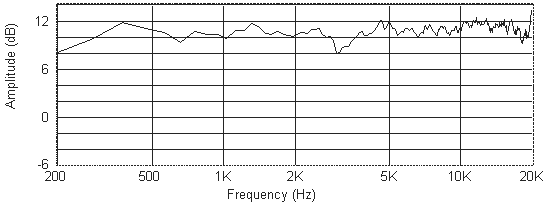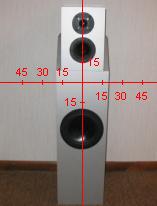

Performance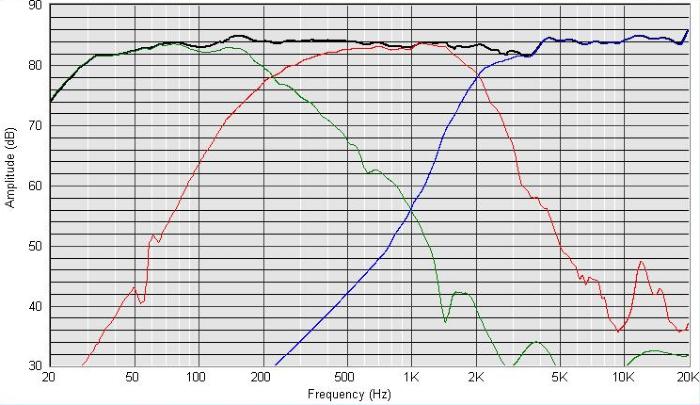 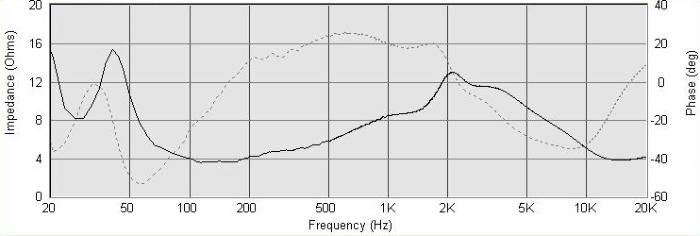 The series of plots below represent the frequency response of the Daedalus taken at various listening angles including +/-15 degrees vertically and +/-15, 30 and 45 degrees horizontally. The measurements were taken at a distance of 1 meter with the microphone onaxis point at the tweeter height. Move your mouse over the cabinet picture to see the response at different angles and click on the picture to see the response with the grills on or off. Based on these measurements the response with the grills removed is a bit better than with the grills on despite the fact that I lined the inside of the grill near the tweeter with acoustic felt in order to try to reduce the grill frame diffraction. The main issue with the response with the grills on is the dip around 3kHz which is a bit more severe. However this is in a region where a lot of speaker designers intentionally place a dip in order to decrease the harshness of the midrange (this is commonly known as a BBC dip). There are also a few other dips higher in frequency which are less severe but still large enough to be noticeable. Another phenomenon related to the grills is the slight boost in output below 2kHz which I've seen in some of my other designs which use grills.
I'll start at the top with the RS28a tweeter. The RS28a is probably the best sounding metal dome tweeter I've ever heard although I've only heard a few and have yet to audition the Seas 27TBFC/G. It simply doesn't sound like a metal dome but is very detailed, clean, clear and very smooth. I chose to flatten out the top end of the response with my crossover because the natural roll off of the RS28 is noticeable to me. My hearing extends beyond 16kHz but for those whose hearing rolls off before this point this may not be necessary. The RS28a is probably in the same league as my old favorite tweeter the Hiquphon OW1 except it doesn't have quite as good off axis performance and doesn't have as much sparkle and air at the top end but this extra presence could just be higher order distortion in upper frequencies. The RS28a rolls off quickly as you go off axis and I've found that I prefer having the speakers toed in so you are listening to the tweeters on axis. A secondary reason for the toe in is to preserve the slight dip at 3kHz as opposed to a slight off axis peak in that region. Next is the RS125 midrange driver. With my crossover I was able to get a very balanced midrange sound out of these speakers. The midrange is very detailed, clear and pretty smooth. I would have to say that they have a more musical sound than the midrange of the Alpheus which seems to be a bit more dry and analytical. The midrange is not as warm as that of the Alpheus design but is a bit stronger in the center of its response giving them a smoother, more prominent midrange. Because of the stronger midrange they sound a bit more forward but also are very detailed at the same time. They still aren't as warm as some of the paper cones that I've heard but some of that paper cone warmth can be considered a coloration of the sound. The aluminum cones can tend to reveal any recording flaw which makes them a bit sensitive to poor recordings but they really excel when you feed them something nice and clean... as they say, garbage in/garbage out. The RS225 covers the region from 300 Hz down and does an excellent job at it. The enclosure simulations reveal an f3 of around 30 Hz but in room responses put it somewhere in the mid to low 20's. I have very few recordings that extend below the bottom end limits of these speakers. The only thing they might have trouble with would be pipe organs and some electronic music but I would still consider them to be full range speakers. I would think that the only time you would want a subwoofer with these speakers is when you're watching movies. This design definitely doesn't suffer any of the stereotypical problems associated with ported enclosures. The bass is deep and tight, not boomy at all. Aside from the normal room modes that I have to deal with, the bass is pretty balanced across the spectrum. Listening ImpressionsEntire Alpheus speaker project description is based on use of faulty tweeters used during crossover design. Go here for details. Section below is based on impressions with faulty XT19 tweeters installed during evaluation.It's hard to find a single word that best describes the sound of the Daedalus design but if I had to pick one word it would have to be "balanced." There are no peaks in response that jump out at you which gives them a very neutral, natural sound. They are also very detailed but can still get a bit congested if there is a lot of stuff going on in the music at once which can make it hard to distinguish separate instruments if there are a lot of them. Some of this congestion could be due to the fact that they have a soundstage that isn't very deep. In a direct comparison with my Asterion 2 way design I found that the Asterion had a much deeper, three dimensional soundstage although the frequency response wasn't quite as neutral. Even the Alpheus three way design has more soundstage depth (but not as much as the Asterion design) although all three designs have excellent imaging characteristics. I would have to say that the lack of depth in the soundstage of the Daedalus is their biggest weakness. I've recently redesigned the Alpheus speaker and replaced it by the newer Alpheus MkII design which uses a different midrange driver than before. The previous version of the Alpheus had strengths and weaknesses compared to the Daedalus design but the new version seems to surpass the Daedalus in most categories. Compared to the Daedalus, the Alpheus design seems like it has slightly less baffle step compensation giving them a little less warmth from 200 Hz down. This makes the bass of the Alpheus sound a bit cleaner and clearer but some of this could be due to the L22 driver which seems to have a lot of detail in its presentation. The midrange of the Daedalus is more forward and may be a bit more detailed than the Alpheus MkII but the Alpheus MkII design still has a lot of midrange clarity. I prefer the treble of the Alpheus MkII because I find that it has more sparkle and life while still remaining clean and smooth. The biggest difference in sound between these two designs has to be the soundstage depth and presentation. The Daedalus speakers have a very forward midrange presentation and a very flat soundstage. The Alpheus MkII has a slightly forward midrange but much more soundstage depth and spaciousness although still not as much as the Asterion design. The imaging of the Daedalus is slightly more focused but the sacrifice is soundstage depth. One major difference between these two designs is that the midrange of the Alpheus MkII isn't quite as "crowded" which makes them a little less fatiguing with music that has a lot of stuff going on in the midrange region. So based on my preferences I think the Alpheus MkII is a nicer sounding speaker to my ears but it all depends on what type of sound you are after. So I think that just about sums it up. If you plan to build a pair of Daedalus you can get most of the parts from Parts Express and the total cost for parts including MDF, drivers, crossover parts, and vinyl (basically everything) is around $600 for a pair. I haven't done any direct comparisons but I have a feeling that this design can outperform many commercial designs selling for over $2000 a pair so if you are skilled at carpentry and soldering you can have quite a bargain if you build a pair of these. They are definitely the best sounding speakers I've built so far and even though they are a bit more expensive than some of my other projects they are well worth the money. 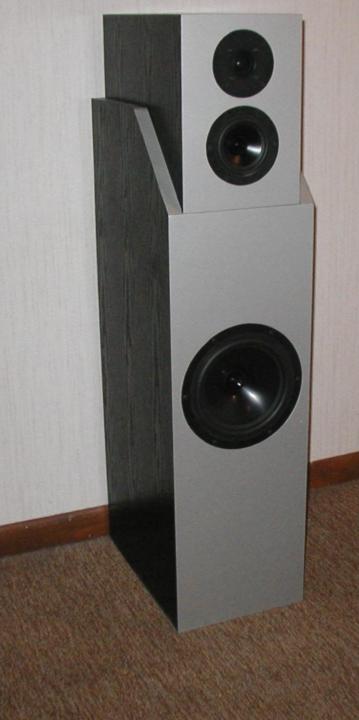 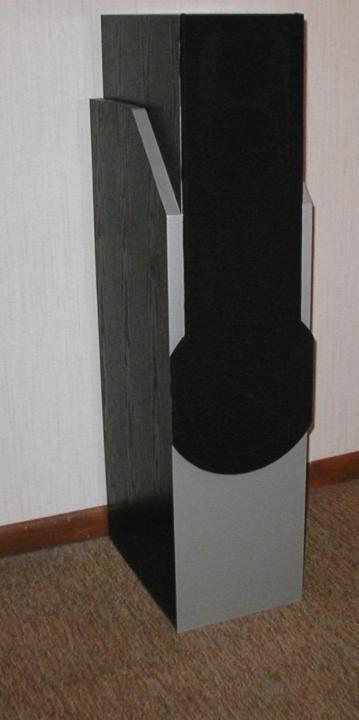 Speaker Workshop Project FileThe Speaker Workshop project file for this design is now available for download: Daedalus.swd. This project includes gated measurements for all of the drivers and a crossover network simulation. There are also some nearfield measurements of the midrange and woofer. The file is about 2 MB in size so be patient if you have a slower connection.ReviewsSo far one other person, Paul O'Neal, has completed a set of Daedalus speakers. He chose a slightly different cabinet design externally. He also decided to use a hinged door on the back of the top cabinet that opens to reveal the crossover lit by a white LED connected to a reed switch, resistor and 9V battery. He chose to put the port on the front to allow closer placement of the cabinet to the back wall. Unlike me he chose not to use any electrolytic capacitors and went with all metallized poly caps. Pictures of his finished speakers are below.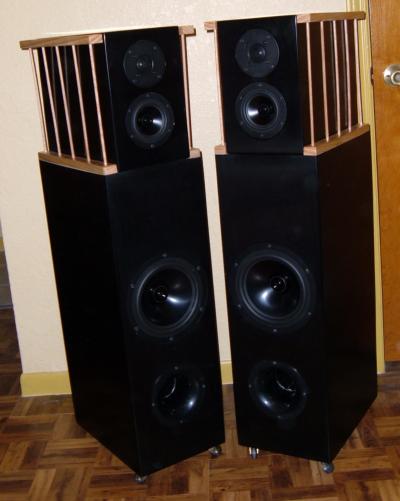 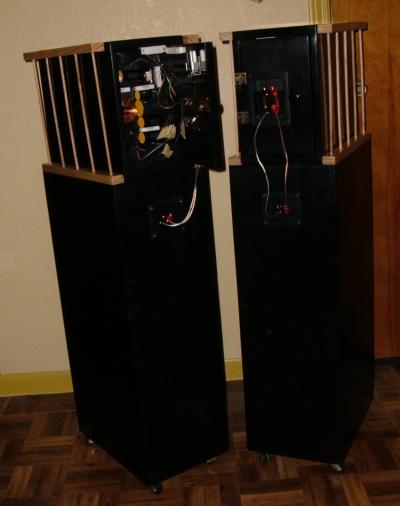 Below is a review of Paul's Daedalus three way speakers in his own words.... "To say that I was anxiously awaiting completion of this speaker is an understatement. I wanted to hear them as I was working on the project, but I maintained because I knew if I started experimenting before the boxes were all done that I would never complete this project. Once all the building, painting, crossover work, etc was finished I fired them up and the biggest grin Iíve experienced in awhile could not be wiped from my face. Sure I started nick picking but I took my time and decided to let them fully break in for a month before I wrote anything official. I donít have a large CD/DVD collection but I listened to what I had many times as well as FM and Digital Radio. Digital radio is through Time Warner Cable. I was worried that the tweeter would make the system sound metallic. I had a pair of entry-level metal 2.5 ways from Infinity a few years ago, and I didnít particularly care for the metal sound of that tweeter. My fears were put to rest. My favorite song to listen for metal harshness is 'Dust in the Wind' by Kansas. There is a particular point in the song where the notes start fairly high and then keep going up. Some tweeters will start distorting on this test and sound very shrill and harsh, but the RS28 handled it with ease. Another test that I use for the tweeter is from the DVD 'Diana Krallís Montreal Jazz Festival'. At one point the drummer uses these many flimsy metal strings attached to a stick and orbits the drum in a circular fashion. On many speakers you can barely hear this. The RS28 brought it in clearly and distinctly. Itís the best Iíve heard that particular passage played on a tweeter before. Moving on to the midrange. The first thing that struck me was how small this driver was. The tweeter is almost as big :). I thought to myself, gee, could such a small mid/woofer live up to the task of providing fulfilling midrange? Again, the answer is yes! Returning back to the Montreal Jazz Festival, I like to test the midrange by listening to the piano and guitar. Iíve never heard the guitar and piano sound so real. Itís like they were playing right in front of me. I also used The Eagles-Hell Freezes Over for midrange testing. Again acoustic guitars sounded wonderful. Voicing was upfront and clear. Instruments could be placed in the appropriate field. The RS125 is a wonderful midrange experience. So how was the bass from the RS225 8Ē? This is what started that big ole grin in the first place. Talk about a low hitting, distortion free, well controlled bass! I was very impressed. As I was building the bass box, I thought about sealing it up because I was afraid the port may chuff and it would sound boomyóNOT! This is the best sounding vented bass box Iíve heard to date. Very, very musical to say the least. The bass playerís upright bass on the Diana Krallís DVD sounded absolutely marvelous. But the drum solo on the Eagles where Don starts out high and goes across to low was just absolutely stunning. Overall, I have to give these speakers two thumbs up. The box design delivers a box that is resonant free and definitely passes the knuckle rap test. They are very detailing and exact. This can cause bad recordings to sound even worse so be careful not to use a bad recording for reviewing. Personally, I think they sound best on classical, easy listening, jazz, oldies and soft rock. I donít have mine toed in because my room doesnít allow me too and it would look odd if I did. I canít really tell that much difference anyway as I did try it. These speakers image pretty darn good, but as you get up and walk around the room you can hear subtle differences. They are fairly efficient at around 84.5db and my HK AVR 320 putting out 55wpc has no problem driving these. In conclusion, I like these guys a lot and have no intention of selling them like I have all my other designs. Well, leastwise for now until the bug hits me again :). Therefore, I wholly give my all out recommendation to these for anyone wanting to build a three way audiophile grade speaker." |
